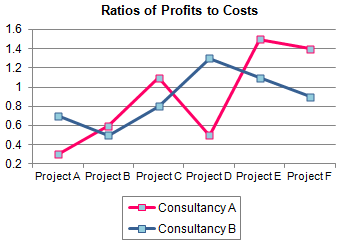Advanced Ratios in Numerical Ability Tests
To measure your aptitude numerical reasoning questions often consists of percentages, ratios, proportions and other arithmetic functions. It is important to note that basic understanding of these concepts alone is not sufficient to succeed in numerical ability tests. To gain good score it is important that you know how to work with these functions in scope of psychometric testing. The below section will look at advanced ratio practice questions to demonstrate the necessary.
How to work out advanced ratios questions
In your numerical ability test you may be required to calculate ratios and proportions from tables, graphs or charts with data presented in wide range of forms i.e. decimals, fractions, percentages etc. The below example demonstrates how to compare fractions expressed in decimal form. It shows how to make quick and accurate judgments by eyeballing the data without the use of calculator.
 |
In how many more projects have profits of consultancy A exceeded costs compared to consultancy B?
At first it may seem impossible to work this out without the use of calculator. Nevertheless all what is required here is to use your aptitude to carefully inspect the data. To start with you need to determine the number of projects of consultancy B which had higher profits than costs. To establish this you have to look for projects that have ratio higher than 1 which corresponds to Projects D and E. Now you may ask why to look for project with ratio higher than one. Take as an example project D and convert 1.3 into fraction. You will get 13/10. As it is given in table header the ratios are expressed 'profits to costs' and hence you may conclude that in Project D profits exceeded costs. The same applies to Project E.
As far as consultancy A is concerned you can clearly see that Project A, B and D had lower profits than expenses as the ratio is lower than 1 (remember, if you divide lower number with greater you will always get number lower than 1). Conversely, Project C, E and F had higher profits than costs and hence you may deduct that earnings of consultancy A have had to exceeded costs in one project compared to consultancy B. If you find the above puzzling you can see easier tutorials from ratios and proportions aptitude test guide to get basic understanding of ratios.
How to work out unknown ratio values
Following on from the above, the below question looks at how to work out unknown value of ratio expressed as decimal number. For the following consider the question below.
If the cost of project C was £8,500 then what was the profit made by Consultancy A?
The above problem may be seemingly puzzling for candidates that are new to concepts of ratios and proportions and don’t have extensive experience in this area. At first, some applicants may be well surprised to see such questions in numerical reasoning tests nevertheless to solve the above you need to convert 1.1 into fraction, that is, 11/10. Now, as the ratio of profits to costs is 11/10 then simply divide £8,500 by 10 to get £850 and add this to £8,500, that is, £8,500 + £850 = £9,350. It’s that simple. To be quick in your workings and calculations practice computing similar kinds of problems at daily bases.

